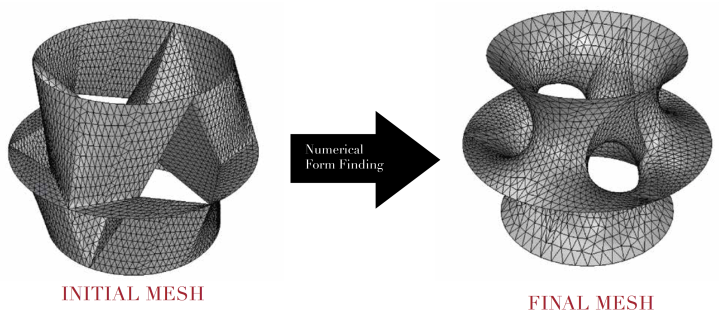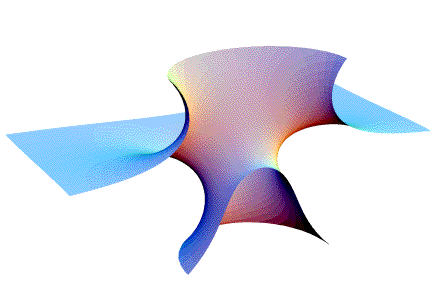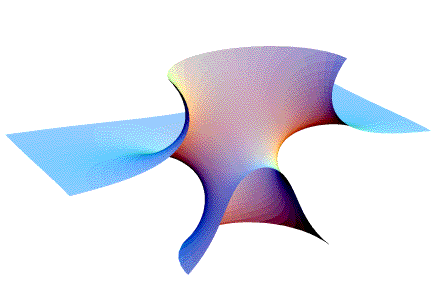How can we algorithmically approximate the form of the mathematically defined Costa surface? This question is at the center of this second blog post of the “physical Costa surface”series.
The form finding approach introduces a physical dimension to the equation generating the minimal surface. Finding the shape can be done in several ways. However, whether it is physical form finding or numerical form finding, the process implies that the initial geometry of the material is relaxed in the final state under a given set of loads (such as gravity, or pre-stressing). In our case, an initial mesh is pre-stressed isotropically and then relaxed to find the final shape (see figure below).

The initial mesh is created by defining a four hole costa surface geometry. The image below shows how this intricate surface appears when cut along a vertical plane of symmetry. In this image two holes are cut and one is hidden. In order to create the initial mesh, the surface is divided once more along the vertical symmetry plane perpendicular to the first cutting plane. The observation of a quarter of the Costa surface geometry helps us create an initial mesh made of low curvature surfaces. this mesh is then adjusted for the six hole geometry. The initial mesh for the analysis appears in the image above.

The actual form finding takes place once the initial mesh has been determined. Three numerical methods were used in the form finding process: (1) Direct resolution of the system by Newton’s Method (2) Natural Force Density Method (NFDM) and (3) Dynamic Relaxation Method (DRM). The initial mesh is prestressed isotropically and allowed to relax into the final geometry with the three fixed ring boundaries seen the figures. The surface area of the initial mesh is 9.083 m2.

The three methods used converge to final mesh areas between 8.25 m2 and 8.29 m2. The three numerical methods used effectively reduced the surface area of the initial mesh under the given boundary conditions, and created suitable final configurations that are close to the actual minimal surface. Among the three methods, dynamic relaxation produced a final configuration with a smallest surface area of 8.248 m2, but needed the longest computation time to converge. NFDM and Newton’s method both achieved convergence with satisfactory results and much shorter computation time
It is not possible with a material to achieve the final form without taking into account the construction phase. The construction of the textile surface will be detailed in the next and final post of the series. Stay tuned!
Author: Victor Charpentier
Thanks to Princeton University graduate students Xi Li, Max Coar, Tracy Huynh and Olek Niewiarowski for their contributions.


2 thoughts on “A Physical Costa Surface 2/3: Form Finding Process”